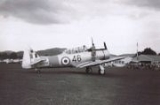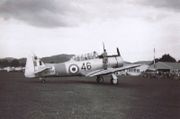
Pilot Training School
Encyclopedia
Origins
Military pilot training during World War I was undertaken by private contractors; principally the New Zealand Flying SchoolNew Zealand Flying School
The New Zealand Flying School was formed in 1915, by the Walsh Brothers, Leo and Vivian, to train pilots for the Royal Flying Corps. The school flew a fleet of home-built and imported flying boats from Mission Bay on Auckland's Waitemata Harbour, near where a sculpture now stands to commemorate...
of the Walsh Brothers
Walsh Brothers Flying Boats
The Walsh Brothers Flying boats were World War I pilot training aircraft from New Zealand.-Walsh Brothers:Brothers Leo and Vivian Walsh built and flew a Howard Wright biplane in 1910 and flew it on 5 February 1911...
in Auckland and the Canterbury Aviation Company formed by Henry Wigram
Henry Wigram
Sir Henry Francis Wigram was a British-born New Zealand businessman, politician and aviation promoter. He is best known for his role in developing a public transport system in Christchurch and as a key player in the establishment of the Royal New Zealand Air Force.-Early life and business:The son...
in Christchurch.
When the New Zealand Permanent Air Force was formed in June 1923, war surplus Avro 504
Avro 504
The Avro 504 was a World War I biplane aircraft made by the Avro aircraft company and under licence by others. Production during the War totalled 8,970 and continued for almost 20 years, making it the most-produced aircraft of any kind that served in World War I, in any military capacity, during...
K and Bristol F2B Fighters transferred from Britain were used for training purposes, supplemented from 1929 by de Havilland Gypsy Moths and replaced from 1931 by Hawker Tomtit
Hawker Tomtit
-Bibliography:*Jackson, J.J. British Civil Aircraft 1919-72: Volume II. London: Putnam and Company, 1973. ISBN 0-85177-813-5* Mason, Francis K. Hawker Aircraft since 1920. London: Putnam & Company, 3rd revised edition 1991. ISBN 0-85177-839-9....
s and Avro 626s. A single two seat Gloster Grebe
Gloster Grebe
-See also:-References:NotesBibliography* James, Derek N. Gloster Aircraft since 1917. London: Putnam and Company Ltd., 1987. ISBN 0-85177-807-0.* Thetford, Owen. Aircraft of the Royal Air Force 1918-57. London:Putnam, First edition 1957....
provided conversion training on that type. in anticipation of the delivery of Vickers Wellington
Vickers Wellington
The Vickers Wellington was a British twin-engine, long range medium bomber designed in the mid-1930s at Brooklands in Weybridge, Surrey, by Vickers-Armstrongs' Chief Designer, R. K. Pierson. It was widely used as a night bomber in the early years of the Second World War, before being displaced as a...
bombers, twin engine monoplane training began on the first of 229 Airspeed Oxford
Airspeed Oxford
The Airspeed AS.10 Oxford was a twin-engine aircraft used for training British Commonwealth aircrews in navigation, radio-operating, bombing and gunnery during the Second World War.-Design and development:...
s in 1938.
World War II
By the outbreak of World War IIWorld War II
World War II, or the Second World War , was a global conflict lasting from 1939 to 1945, involving most of the world's nations—including all of the great powers—eventually forming two opposing military alliances: the Allies and the Axis...
the more modest of these types had been formed into 1 Flying Training School (FTS) at Wigram
Wigram
Wigram is a suburb of Christchurch, New Zealand. Technically called Wigram Park, the second half of its name is rarely if ever heard. The suburb lies close to the industrial estates of Sockburn and the satellite retail and residential zone of Hornby...
, while advanced training on types such as the Oxford had been separated. Due to the Commonwealth Air Training Plan, other schools were under construction at Taieri, and Woodbourne. A large number of additional FTS followed with the first few years of the war, while from 1939 335 de Havilland Tiger Moth
De Havilland Tiger Moth
The de Havilland DH 82 Tiger Moth is a 1930s biplane designed by Geoffrey de Havilland and was operated by the Royal Air Force and others as a primary trainer. The Tiger Moth remained in service with the RAF until replaced by the de Havilland Chipmunk in 1952, when many of the surplus aircraft...
s manufactured in Wellington
Wellington
Wellington is the capital city and third most populous urban area of New Zealand, although it is likely to have surpassed Christchurch due to the exodus following the Canterbury Earthquake. It is at the southwestern tip of the North Island, between Cook Strait and the Rimutaka Range...
provided the main primary trainers. Until 1941 much advanced training was done on retired combat types such as the Hawker Hind
Hawker Hind
-See also:-Bibliography:* Crawford, Alex. Hawker Hart Family. Redbourn, Hertfordshire, UK: Mushroom Model Publications Ltd., 2008. ISBN 83-89450-62-3....
, Vickers Vildebeest
Vickers Vildebeest
The Vickers Vildebeest and the similar Vickers Vincent were two very large two- to three-seat single-engined British biplanes designed and built by Vickers and used as a light bomber, torpedo bomber and in the army cooperation roles...
and Fairey Gordon
Fairey Gordon
|-See also:-External links:* * *...
but these were gradually replaced by 202 locally assembled North American Harvards.
Post war


Wigram
Wigram is a suburb of Christchurch, New Zealand. Technically called Wigram Park, the second half of its name is rarely if ever heard. The suburb lies close to the industrial estates of Sockburn and the satellite retail and residential zone of Hornby...
. The Tiger Moths were phased out, Harvards being used for ab intio training, de Havilland Devon and two seat De Havilland Vampire
De Havilland Vampire
The de Havilland DH.100 Vampire was a British jet-engine fighter commissioned by the Royal Air Force during the Second World War. Following the Gloster Meteor, it was the second jet fighter to enter service with the RAF. Although it arrived too late to see combat during the war, the Vampire served...
s being used for advanced training. 1 FTS became the Pilot Training Squadron in 1966. The squadron received a small number of AESL Airtourer
AESL Airtourer
-Trivia:*Probably not the 1st 2 seat side by side aircraft designed with a central 'stick' but one of the 1st with a 'square hand grip' version.*Easy to fly from both seats due to the central stick design and arm rest....
in 1970 and re-equipped with Pacific Aerospace CT-4B Airtrainers in 1976, these subsequently being replaced by more powerful CT-4Es.
Advanced training on BAC Strikemaster and Aermacchi MB-339
Aermacchi MB-339
The Aermacchi MB-339 is an Italian military trainer and light attack aircraft. It was developed as a replacement for the earlier MB-326.-Design and development:...
shifted to No. 14 Squadron RNZAF
No. 14 Squadron RNZAF
14 Squadron RNZAF was a squadron of the Royal New Zealand Air Force.- New Zealand fighters before 1941 :Until World War II, New Zealand's air force concentrated on training, transport and maritime attack. The vast distance of the Pacific Ocean seemed a defence against attack by air...
, twin engined training on Fokker Friendships and later Cessna Golden Eagle
Cessna 421
-See also:-References:NotesBibliography* Taylor, John W.R. . Jane's All The World's Aircraft 1976-77. London:Jane's Yearbooks, 1976. ISBN 0-354-00538-3....
s and Beechcraft Super King Air
Beechcraft Super King Air
The Beechcraft Super King Air family is part of a line of twin-turboprop aircraft produced by the Beech Aircraft Corporation . The King Air line comprises a number of model series that fall into two families: the Model 90 series, Model 100 series , Model 200 series and Model 300 series...
s being undertaken by No. 42 Squadron RNZAF
No. 42 Squadron RNZAF
42 Squadron of the RNZAF was formed at Rongotai in December 1943 to provide a communications service around New Zealand, initially using impressed civilian types. It was briefly officially disbanded in 1946, but its aircraft continued with general purpose operations at RNZAF Base Ohakea...
. No. 3 Squadron undertook basic rotary training with the Bell 47
Bell 47
The Bell 47 is a two-bladed, single engine, light helicopter manufactured by Bell Helicopter. Based on the third Model 30 prototype, Bell's first helicopter designed by Arthur M. Young, the Bell 47 became the first helicopter certified for civilian use on 8 March 1946...
. When Wigram closed in 1993 the squadron shifted to Ohakea.
Current Syllabus
Currently Students are put through a 34 week course of lectures and flying, the later being 108 hours dual instruction and 38 hours solo flying and then are streamed into rotary or multi engine courses before acquiring their wings. Some Malaysian and Singaporean Air Force pilots are also trained.The Squadron motto is 'ab ovo usque', (Latin; 'from the beginning').
Course Syllabus

